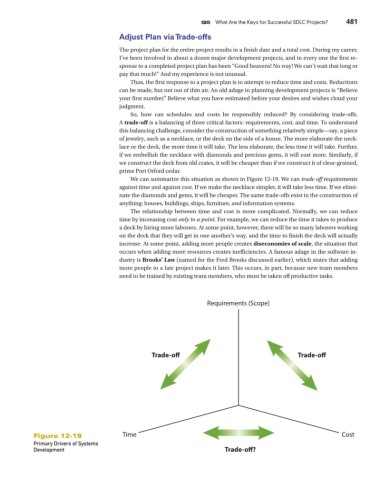Page 513 - Using MIS
P. 513
Q5 What Are the Keys for Successful SDLC Projects? 481
Adjust Plan via Trade-offs
The project plan for the entire project results in a finish date and a total cost. During my career,
I’ve been involved in about a dozen major development projects, and in every one the first re-
sponse to a completed project plan has been “Good heavens! No way! We can’t wait that long or
pay that much!” And my experience is not unusual.
Thus, the first response to a project plan is to attempt to reduce time and costs. Reductions
can be made, but not out of thin air. An old adage in planning development projects is “Believe
your first number.” Believe what you have estimated before your desires and wishes cloud your
judgment.
So, how can schedules and costs be responsibly reduced? By considering trade-offs.
A trade-off is a balancing of three critical factors: requirements, cost, and time. To understand
this balancing challenge, consider the construction of something relatively simple—say, a piece
of jewelry, such as a necklace, or the deck on the side of a house. The more elaborate the neck-
lace or the deck, the more time it will take. The less elaborate, the less time it will take. Further,
if we embellish the necklace with diamonds and precious gems, it will cost more. Similarly, if
we construct the deck from old crates, it will be cheaper than if we construct it of clear-grained,
prime Port Orford cedar.
We can summarize this situation as shown in Figure 12-19. We can trade off requirements
against time and against cost. If we make the necklace simpler, it will take less time. If we elimi-
nate the diamonds and gems, it will be cheaper. The same trade-offs exist in the construction of
anything: houses, buildings, ships, furniture, and information systems.
The relationship between time and cost is more complicated. Normally, we can reduce
time by increasing cost only to a point. For example, we can reduce the time it takes to produce
a deck by hiring more laborers. At some point, however, there will be so many laborers working
on the deck that they will get in one another’s way, and the time to finish the deck will actually
increase. At some point, adding more people creates diseconomies of scale, the situation that
occurs when adding more resources creates inefficiencies. A famous adage in the software in-
dustry is Brooks’ Law (named for the Fred Brooks discussed earlier), which states that adding
more people to a late project makes it later. This occurs, in part, because new team members
need to be trained by existing team members, who must be taken off productive tasks.
Requirements (Scope)
Trade-o Trade-o
Figure 12-19 Time Cost
Primary Drivers of Systems
Development Trade-o?

